My Kind of School
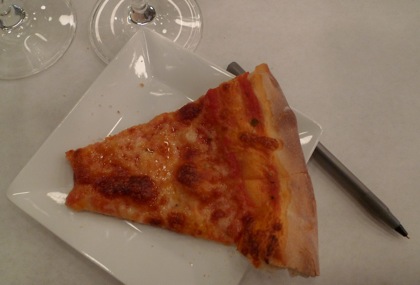 When New York Vintners invited me to come to one of its many classes, I’m afraid I didn’t venture too far from my core interests. “Premium Sake and Asian Tapas,” “Wines of the Southern Hemisphere,” “Building Your Own Palate”—the options are wide-ranging. “Pizza and the Wines That Love It,” however, had my name written all over it.
When New York Vintners invited me to come to one of its many classes, I’m afraid I didn’t venture too far from my core interests. “Premium Sake and Asian Tapas,” “Wines of the Southern Hemisphere,” “Building Your Own Palate”—the options are wide-ranging. “Pizza and the Wines That Love It,” however, had my name written all over it.
Last Sunday’s two-hour class started at 4 p.m., and I was excited just to see the back half of the space, where the kitchen is. (The “office” in the middle of the room is on a track, and it can be moved forward or backward depending how many people New York Vintners is hosting. They can seat up to 50 at regular tables or accommodate cocktail parties as large as 90.) Most of the 20 other students were already seated when I arrived, and most appeared to be in their thirties and forties. The class was during the Jets game, which may be why only three other men were there.
In-house chef Christopher Meeker—who has worked in Europe, Houston, Westchester, and Santa Barbara, including a stint as private chef—soon got started. First, he let us know that we wouldn’t be making dough, because: a) It takes two hours to rise, and b) you can buy good dough cheaply at pretty much any pizza joint and Whole Foods, where today’s was coming from.
Meeker has personality to spare, which helped the large amount of pizza-making tips and advice go down very easily. When I looked back at my notes later, I was surprised at how much I learned….
Equipment
• Baking your pizza on a pizza stone is great because the stone, which is porous, and wicks away moisture. Moisture is no friend of pizza. (See “Toppings,” below.)
• Those pie pans/baking sheets with holes will also do well enough.
• The big paddle that pizzerias use—one often comes with the stone—is called a peel.
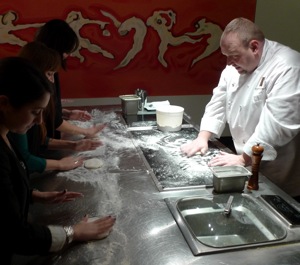 Dough
Dough
• You want to work with dough when it’s cold.
• If you have a ball of dough that makes two pizzas, always bisect it horizontally; cut it vertically and you’ll never get the dough round again.
• If you don’t want to stretch the dough by tossing it, use the 12-6-12 method: While the dough is lying on a flat surface, hold the top steady with one hand while the other hand presses the dough out in half-circle motions (from 12 o’clock to 6 o’clock, and then from 6 o’clock to 12 o’clock).
• To fix a tear, overlap a bit of dough over the tear and gently work it in.
• Pinch the circumference to make it nice and thin. The tastier your crusts, the less likely you are to end up with plates full of “pizza bones.”
• Whole-wheat dough oxidizes quickly, turning gray at the edges, so use it immediately if you must use it at all. (“If it wasn’t for the fact that you people like healthy food I wouldn’t make whole-wheat pizza!” said Meeker. “I support eating for nutrition—as long as it doesn’t inhibit eating for pleasure.”) Also, whole-wheat dough takes longer to bake: 8–12 minutes versus 7 minutes for normal dough, if I remember correctly. We were drinking wine….
Sauce and toppings
• To make pizza sauce, add a tablespoon of honey to your favorite pasta sauce. (Pizza sauce is traditionally sweeter than pasta sauce in order to balance the saltiness of toppings.) Use a wand blender to smoothen it. My neighbor, however, said that she adds honey to the dough, not the sauce. She was from Staten Island and vehement about this point.
• Apply just enough tomato sauce to coat.
• The more toppings, the soggier the pizza. Plus, toppings add pressure on the dough, keeping it from cooking properly. (The center doesn’t cook enough.) Try to max out at three toppings.
• That’s why pizzerias use a special low-moisture mozzarella—and if they’re using fresh mozzarella, it’s designed specially for pizza. If you’re using fresh mozzarella, let it drain after you slice it.
• Smoked mozzarella, however, tends to be a little drier from the start because it’s been smoked. Meeker bought his smoked mozzarella from Sid Wainer; I’m not a big fan of smoked mozzarella but it tasted great.
• Precook any vegetable toppings—quickly sauté them, then drain. It’ll remove moisture and your veggies will get color while baking.
Baking
• Cornmeal is a handy way to slide the pizza from the peel to the stone. It releases methane while baking, however, which bothers some people’s eyes.
• Halfway through baking, rotate the pizza 180 degrees. Every oven has a hotspot. (This is a good rule no matter what you’re baking.)
• Resist the temptation to open the door unnecessarily. In two seconds you can lose 100 degrees.
That sounds like a barrage of information, but it didn’t feel that way, perhaps because we were also eating pizza fresh from the oven. (How was the pizza? I’m a pizza snob, willing to cross rivers for a good pie, and I don’t think it’s fair to compare homemade pizza to pizzeria pizza—but I’d gladly have this pizza at home any day of the week. Well, not the whole-wheat one.)
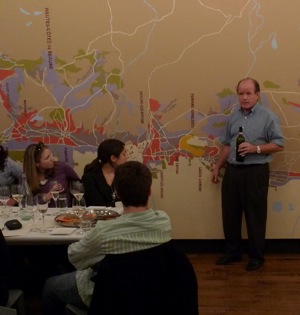 Meeker tag-teamed with New York Vintners wine consultant Gerard Quirk. Quirk didn’t tell us what to taste in each wine, instead teaching us how to taste wine in general, so that we could come to our own conclusions:
Meeker tag-teamed with New York Vintners wine consultant Gerard Quirk. Quirk didn’t tell us what to taste in each wine, instead teaching us how to taste wine in general, so that we could come to our own conclusions:
1. First, look at it. Tilt the glass 45 degrees, and be sure to look at the wine against a white background, such as the tablecloth. The key word is vibrancy: “And even if it’s a hippy, biodynamic type of wine it shouldn’t be dull,” said Quirk. And you don’t ever want murky wine.
2. Stick your nose in the glass. Smell the wine. Is it aromatic? What does the smell remind you of? “Citrus, perhaps?” asked Quirk, trying not to lead the witnesses too much. (We were still on Prosecco, so he reminded us that you don’t swirl sparkling wine because the bubbles will dissipate.)
3. Take a taste. Wine tasters have no problem slurping, because air brings out the flavor. Quirk said some tasters almost chew the wine, for as long as a few minutes. Again, rather than insisting we taste what he tasted, he suggested questions we should ask no matter what wine we were drinking: Does it taste the way it smells? How long does the taste last? Does it have a certain complexity? A major goal is balance: If any one factor jumps out at you—if the alcohol is overpowering—there might be a problem.
Quirk also talked about terroir and appellations, and then there was a diversion into sparkling wines—Prosecco vs. Champagne and cava—that I kind of tuned out, to be honest, having covered much of that ground last month.
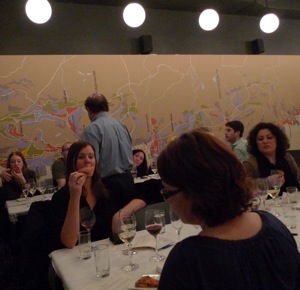 We tasted six wines…
We tasted six wines…
1. Botter NV Verduzzo Prosecco from the Veneto
2. Sartarelli 2008 Verdicchio Classico, from Le Marche
3. Roccaperciata 2008 Grillo from Sicily
4. Pico Maccario 2008 Barbera d’Asti from Piedmont
5. Valdarno Superiore 2007 Chianti from Tuscany
6. Terredora 2008 Aglianico from Campania
…and we didn’t learn their prices until the end. I was pleasantly surprised that they ranged from only $10 to $15 per bottle. And I liked the Aglianico so much, I bought a bottle of it to take home. I always was the kind of student who went for extra credit.
New York Vintners’ full schedule is here. The next “Pizza and the Wines That Love It” class is on Saturday, Feb. 6; it costs $45, though several folks at my class paid less because they signed up via Groupon. 21 Warren St. (bet. Broadway and Church); 212-812-3999, newyorkvintners.com.







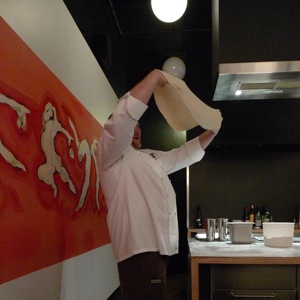







Chris- The writer obviously enjoyed his experience with you. Your enthusiasm for your food and cooking comes through. You can fix pizza for us anytime. Great Article. L-Dad
Great article and seems Chef Meeker is a very talented chef. Wish I lived in New York so I could take advantage of this great program. Keep up the good work.
Go Cuse!!